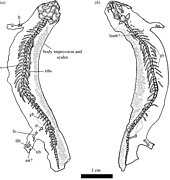Recumbirostra
| Recumbirostra Temporal range: Late Carboniferous - Early Permian,
| |
|---|---|

| |
| Life restoration of the rhynchonkid Rhynchonkos | |

| |
| Life restoration of Batropetes, a brachystelechid | |
| Scientific classification | |
| Domain: | Eukaryota |
| Kingdom: | Animalia |
| Phylum: | Chordata |
| Order: | †Microsauria |
| Clade: | †Recumbirostra Anderson, 2007 |
| Subgroups | |
|
see text | |
Recumbirostra is a clade of tetrapods which lived during the Carboniferous and Permian periods. They are thought to have had a fossorial (burrowing) lifestyle and the group includes both short-bodied and long-bodied snake-like forms.[1][2] At least one species, the long-bodied molgophid Nagini mazonense, lost its forelimbs entirely.[3] Recumbirostra includes the families Pantylidae, Gymnarthridae, Ostodolepidae, Rhynchonkidae and Brachystelechidae, with additional families such as Microbrachidae and Molgophidae being included by some authors.[4][5] Brachystelechidae and Molgophidae have also been grouped together in the suggested clade Chthonosauria.[6]
Recumbirostra was erected as a clade in 2007 to include many of the taxa traditionally grouped in "Microsauria", which has since been shown to be a paraphyletic or polyphyletic grouping.[7][8][9] Like other "microsaurs", the recumbirostrans have traditionally been considered to be members of the subclass Lepospondyli; however, many phylogenetic analyses conducted since the 2010s have recovered recumbirostrans as basal sauropsid (reptilian) amniotes instead.[10][7][5][3][11] However, the placement of recumbirostrans as reptiles has been challenged by other authors, who have recovered them as stem-amniotes instead, and contended that the shared characters between recumbirostrans and reptiles are convergent,[12] or the result of incorrect character encoding.[13] Not all phylogenetic analyses recognize Recumbirostra as a valid grouping. An alternative clade called Tuditanomorpha is occasionally supported and includes many of the same taxa.[14] Furthermore, the taxa that are often considered to be recumbirostrans have been found among amphibians (and not as a distinct clade) in some analyses.[15]
Classification
[edit]Taxonomy
[edit]- Altenglanerpeton
- Sparodus
- Steenerpeton?
- Trihecaton?
- Hapsidopareiidae
- Microbrachidae?
- Pantylidae
- Odonterpetidae
- Chthonosauria
- Nastrondormes[16]
Phylogeny
[edit]Below is a cladogram showing the phylogenetic relationships of recumbirostrans from Glienke (2012):[4]
| Recumbirostra | |
Gallery
[edit]-
Skeleton of Joermungandr bolti, showing preserved remains of scales
-
Skeleton of the brachystelechid Batropetes
-
Skull of the molgophid Brachydectes
-
Skull of the ostodolepid Nannaroter
References
[edit]- ^ Mann, Arjan; Calthorpe, Ami S.; Maddin, Hillary C. (2021). "Joermungandr bolti, an exceptionally preserved 'microsaur' from the Mazon Creek Lagerstätte reveals patterns of integumentary evolution in Recumbirostra". Royal Society Open Science. 8 (7): 210319. Bibcode:2021RSOS....810319M. doi:10.1098/rsos.210319. PMC 8292758. PMID 34295525.
- ^ Mann, Arjan; Maddin, Hillary C (2019-09-30). "Diabloroter bolti, a short-bodied recumbirostran 'microsaur' from the Francis Creek Shale, Mazon Creek, Illinois". Zoological Journal of the Linnean Society. 187 (2): 494–505. doi:10.1093/zoolinnean/zlz025. ISSN 0024-4082.
- ^ a b Mann, Arjan; Pardo, Jason D.; Maddin, Hillary C. (2022-03-28). "Snake-like limb loss in a Carboniferous amniote". Nature Ecology & Evolution. 6 (5): 614–621. Bibcode:2022NatEE...6..614M. doi:10.1038/s41559-022-01698-y. ISSN 2397-334X. PMID 35347258. S2CID 247778148.
- ^ a b Glienke, S. (2012). "A new "microsaur" (Amphibia; Lepospondyli) from the Rotliegend of the Saar–Palatinate region (Carboniferous/Permian transition; West Germany)". Paläontologische Zeitschrift. 86 (3): 297–311. Bibcode:2012PalZ...86..297G. doi:10.1007/s12542-012-0130-8. S2CID 140699792.
- ^ a b Mann, A.; Pardo, J. D.; Maddin, H. C. (2019). "Infernovenator steenae, a new serpentine recumbirostran from the 'Mazon Creek' Lagerstätte further clarifies lysorophian origins". Zoological Journal of the Linnean Society. 187 (2): 506–517. doi:10.1093/zoolinnean/zlz026.
- ^ Osteology and phylogenetic position of the diminutive 'microsaur' Odonterpeton triangulare from the Pennsylvanian of Linton, Ohio, and major features of recumbirostran phylogeny
- ^ a b Jason D. Pardo; Matt Szostakiwskyj; Per E. Ahlberg; Jason S. Anderson (2017). "Hidden morphological diversity among early tetrapods". Nature. 546 (7660): 642–645. Bibcode:2017Natur.546..642P. doi:10.1038/nature22966. hdl:1880/113382. PMID 28636600. S2CID 2478132.
- ^ Anderson, J.S. (2007). "Incorporating ontogeny into the matrix: A phylogenetic evaluation of developmental evidence for the origin of modern Amphibians". In Anderson, J.S.; Sues, H.-D. (eds.). Major Transitions in Vertebrate Evolution. Bloomington and Indianapolis: Indiana University Press. pp. 182–227.
- ^ Huttenlocker, A. K.; Pardo, J. D.; Small, B. J.; Anderson, J. S. (2013). "Cranial morphology of recumbirostrans (Lepospondyli) from the Permian of Kansas and Nebraska, and early morphological evolution inferred by micro-computed tomography". Journal of Vertebrate Paleontology 33 (3): 540.
- ^ Jason D. Pardo, Matt Szostakiwskyj and Jason S. Anderson (2015). "Phylogenetic relationships of recumbirostran 'lepospondyls' inferred from neurocranial morphology". Society of Vertebrate Paleontology 75th Annual Meeting Program & Abstracts: 191.
- ^ Mann, A.; Pardo, J. D.; Sues, H.-D. (2022). "Osteology and phylogenetic position of the diminutive 'microsaur' Odonterpeton triangulare from the Pennsylvanian of Linton, Ohio, and major features of recumbirostran phylogeny". Zoological Journal of the Linnean Society. 197 (3): 641–655. doi:10.1093/zoolinnean/zlac043.
- ^ Reisz, Robert R.; Maho, Tea; Modesto, Sean P. (2024-12-31). "Recumbirostran 'microsaurs' are not amniotes". Journal of Systematic Palaeontology. 22 (1). Bibcode:2024JSPal..2296078R. doi:10.1080/14772019.2023.2296078. ISSN 1477-2019.
- ^ Modesto, Sean P. (2024-04-02). "Problems of the interrelationships of crown and stem amniotes". Frontiers in Earth Science. 12. Bibcode:2024FrEaS..1255806M. doi:10.3389/feart.2024.1155806. ISSN 2296-6463.
- ^ Henrici, A.C.; Martens, T.; Berman, D.S.; Sumida, S.S. (2011). "An ostodolepid 'microsaur' (Lepospondyli) from the Lower Permian Tambach Formation of central Germany". Journal of Vertebrate Paleontology. 31 (5): 997–1004. Bibcode:2011JVPal..31..997H. doi:10.1080/02724634.2011.596601. S2CID 129710688.
- ^ Marjanović, David; Laurin, Michel (4 January 2019). "Phylogeny of Paleozoic limbed vertebrates reassessed through revision and expansion of the largest published relevant data matrix". PeerJ. 6: e5565. doi:10.7717/peerj.5565. ISSN 2167-8359. PMC 6322490. PMID 30631641.
- ^ Jenkins, Xavier A.; Sues, Hans‐Dieter; Webb, Savannah; Schepis, Zackary; Peecook, Brandon R.; Mann, Arjan (2025-01-07). "The recumbirostran Hapsidopareion lepton from the early Permian (Cisuralian: Artinskian) of Oklahoma reassessed using HRμCT , and the placement of Recumbirostra on the amniote stem". Papers in Palaeontology. 11 (1). doi:10.1002/spp2.1610. ISSN 2056-2799.











